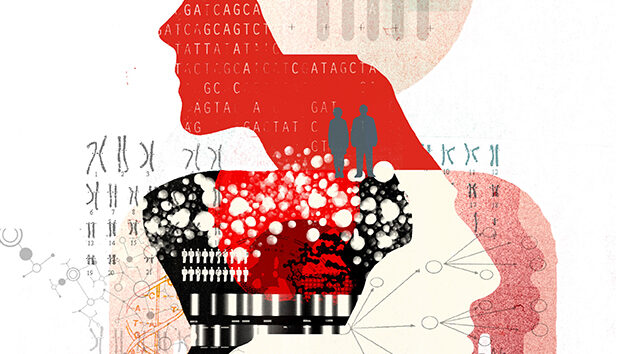If you are a devoted label reader, you’re likely familiar with folic acid, the B vitamin common in multivitamins and fortified foods like breads and breakfast cereals. And if you have been pregnant or tried to become pregnant sometime in the past two decades, you were probably advised to supplement with folic acid to support a healthy pregnancy.
What you might not know is that folic acid is actually an oxidized synthetic-compound version of folate, a naturally occurring water-soluble B vitamin found in certain vegetables (including dark leafy greens), legumes, beef liver, and other whole foods. Folic acid is a stable and inexpensive substitute for folate in supplements and processed foods, and many people, including many healthcare professionals, consider folic acid to be identical to folate.
A growing body of research, however, suggests that the two behave differently in your body — and that difference could have a major impact on your health.
Functional Folate
Almost every cell in the body needs folate to perform optimally. Like all B-complex vitamins, folate helps transform food into fuel, producing essential energy. It aids in the production of DNA and RNA, which is especially important during infancy, adolescence, and pregnancy, when we’re experiencing rapid growth.
Folate also teams up with vitamin B12 to help make red blood cells and facilitate iron absorption in the body. It joins with B6, B12, and other nutrients to control homocysteine, an inflammatory amino acid that, at high levels, has been linked to heart disease. Plus, it supports brain health, helps calm an agitated nervous system, and bolsters the adrenals to manage stress.
In addition to performing all these jobs, folate is essential to a biochemical process called methylation, a constantly running, super-fast shuttle operation that keeps your body’s systems humming. Occurring more than a billion times per second, the methylation process transports clusters of atoms called methyl groups from one molecule to another throughout the body to help it renew and repair itself.
“Methylation is the way biological systems move stuff around efficiently,” says Russell Jaffe, MD, PhD, a functional-medicine researcher and founder of Health Studies Collegium, a Washington, D.C.–area institute focused on sustainable solutions to global health needs.
“Our bodies’ structural parts wear out, and methylation, which allows us to produce something efficiently in one location and then transfer it efficiently to another location, is key to their renewal,” Jaffe explains. “If your body needs to repair a bone, joint, organ, or tissue, for example, you need methylation to make proteins like collagen (the structural ropes that hold us together), elastin (the protein that allows us to be flexible), and the many products of cell metabolism that must be moved from where they are made to where they are needed.”
Many people simply don’t eat enough whole-food sources of folate to get the amount they need for adequate methylation. To make matters more complicated, up to 45 percent of people carry genetic variations, including one known as MTHFR, that can make it difficult for them to process the folate they do consume.
A folate deficiency can cause major health consequences for everyone — not just for mothers-to-be and their babies. A chronic low level of folate has been linked to increased risk for heart attacks and strokes, among other conditions. (See “Signs You Need More Folate,” below, for clues on a possible folate deficiency.)
A Problematic Substitute
In 1998 the U.S. Food and Drug Administration began requiring that folic acid be added to enrich breads, cereals, flours, pastas, rice, and other grain products. The main objective: to reduce the risk of neural tube defects (NTDs) — birth defects of the brain, spine, or spinal cord that include spina bifida and anencephaly.
Nearly half of all pregnancies are unplanned, and expectant mothers who aren’t already getting sufficient folate don’t have enough time to increase their intake before such defects could occur, typically by the fourth week after conception. Pregnant women need 600 micro-grams of folate a day, according to the Institute of Medicine of the U.S. National Academy of Sciences. By enriching flour with synthetic folic acid, scientists estimated that the average woman could get a boost of 100 or more micrograms daily. Studies show the occurrence of NTDs has declined by as much as 32 percent in the nearly 20 years since the implementation of mandated fortification.
While this public-health initiative has been successful, the widespread consumption of folic acid–enriched foods and supplements by adults who are not pregnant has had some unfortunate, unintended consequences.
Folic Acid Vs. Folate
The body absorbs synthetic folic acid faster than it processes folate from whole foods or active supplemental forms of folate. Yet, it needs to work much harder to convert the synthetic folic acid into an active, usable form that aids methylation, requiring multiple enzymatic steps to do so.
For the estimated 45 percent of the population with a genetic variant that affects folate processing, this conversion process can be even more difficult. In fact, people who carry significant MTHFR or other folate-related gene variations may be unable to turn folic acid into folate at all. (For more information about MTHFR and other genetic variations, see “Making Sense of SNPs” .)
Even absent a folate-related genetic variation, the synthetic supplement can cause problems.
Folic-acid metabolites in the bloodstream preferentially bind to folate receptors, which decreases the body’s ability to use natural folate. This can cause folate deficiency and a buildup of unmetabolized folic acid, increasing the risk of certain diseases. Recent research has linked excess levels of folic acid to lung, prostate, and colon cancers. Too much folic acid might also mask a B12 deficiency, which can manifest as depression, as well as dementia and cognitive impairment.
“The more we learn about folic acid, the clearer it is that giving it to everyone has very real risks,” says David Smith, PhD, professor emeritus of pharmacology at the University of Oxford. “There is a subgroup of people who may suffer harm from folic acid — for example, people with low vitamin B12 status and people who carry certain quite-common genes. Furthermore, intake of high amounts of folic acid in pregnancy may cause future harm to the child.”
In a 2016 letter published in The BMJ, Smith and colleagues from Tufts University and the University of Oslo argued against fortifying mandates proposed in Europe. Among other concerns, the authors cite research showing that older people who took daily supplements containing more than 400 micrograms of folic acid suffered significant cognitive decline compared with nonusers.
Problems linked to excess folic acid, however, are not found in association with folate from whole foods. Experts from the Harvard T.H. Chan School of Public Health caution against consuming too many processed foods fortified with folic acid. They recommend eating whole foods to get the folate you need — noting that you can’t overdose on folate in natural foods, since “it comes naturally packaged in balance with other micronutrients, and the body regulates its absorption.”
By learning more about this crucial B vitamin, you can make sure you’re getting enough of the right form.
11 Signs You Need More Folate
Inadequate folate levels can lead to both minor and serious conditions, including anemia as well as elevated concentrations of homocysteine (an inflammatory amino acid) in the blood, often a marker for cardiovascular disease. The following symptoms may be associated with inadequate folate. Talk to your healthcare provider if you suspect a deficiency.
- Breathlessness
- Fatigue or low energy
- Feeling faint
- Heart palpitations
- Irritability
- Mental sluggishness
- Miscarriages
- Pale skin
- Reduced appetite
- Poor digestion
- Faulty immune function
Find the Folate That’s Right for You
Not everyone can get enough folate from the whole foods they eat, explains Stephanie Belseth, CPNP, a functional-medicine specialist and founder of Newbridge Clinic in Edina, Minn. “Some people need dramatically more folate than others due to genetic variants, epigenetics, environmental factors, and stress.” In such cases, the right supplements can make a big difference in an individual’s health.
“I’m an advocate of supplements for the right person and at the right time,” Belseth says. “But they also need to be the right kind, and they ideally need to be taken in consultation with a nutritionally trained healthcare practitioner.”
Getting natural folate from food is always the first recommendation, but some individuals may need more, explains Belseth. “Children with autism, for example, are more likely than not to have cerebral folate deficiency, in which the brain is starving and very deficient in folate. For these children, getting enough folate from whole foods alone can be almost impossible. Supplementing with active forms of folate and other nutrients can sometimes dramatically improve their autistic symptoms.”
If you are advised or decide to augment your natural folate intake, Belseth recommends supplements containing folinic acid or 5-MTHF (also known as L-methylfolate), which are metabolically active forms of folate that your body can best use.
Work with a health professional to ensure you have the right ratio of B12 and folate when supplementing, notes Josie Nelson, founder and certified health coach at Integrative Health Strategies near Washington, D.C. “Not all supplements are created equal, and individual needs vary greatly. Also be sure to use a high-quality supplement that does third-party testing. If you aren’t sure, contact the supplement company and ask them.”
How Folic Acid Can Add Up
You can’t overdose on naturally occurring folate, but it is possible to get too much folic acid, which can cause stomach problems, sleep disturbances, skin reactions, and even seizures. If you eat a lot of fortified foods, you can quickly reach 400 micrograms, the recommended daily allowance of dietary folate equivalent for adults, as determined by the Institute of Medicine (IOM). Add to these a multivitamin with a full day’s supply of synthetic folic acid, and you can easily top the IOM’s recommended daily upper limit of 1,000 micrograms.
| Source | Amount | Folic-Acid Content |
| Vitamin | 1 serving | 400 micrograms |
| Breakfast cereal | 1 cup | 100-400 micrograms |
| White rice | 1 cup cooked | 95 micrograms |
| Pasta | 1 cup cooked | 90 micrograms |
| Flour tortilla | 1 serving | 80 micrograms |
| Instant oatmeal | 1 package | 70 micrograms |
9 Whole-Food Sources For Folate
| Source | Amount | Folic-Acid Content |
| 1. Beef liver | 3 ounces braised | 215 micrograms |
| 2. Lentils | 1/2 cup cooked | 179 micrograms |
| 3. Spinach | 1/2 cup cooked | 131 micrograms |
| 4. Sunflower seeds | 1 1/2 ounces | 101 micrograms |
| 5. Asparagus | 4 spears cooked | 89 micrograms |
| 6. Turnip greens | 1/2 cup cooked | 85 micrograms |
| 7. Broccoli | 1/2 cup cooked | 84 micrograms |
| 8. Brussels sprouts | 1/2 cup cooked | 47 micrograms |
| 9. Egg yolk | 1 large fresh | 25 micrograms |
This article originally appeared as “Follow the Folate” in the March 2017 issue of Experience Life.




This Post Has 0 Comments